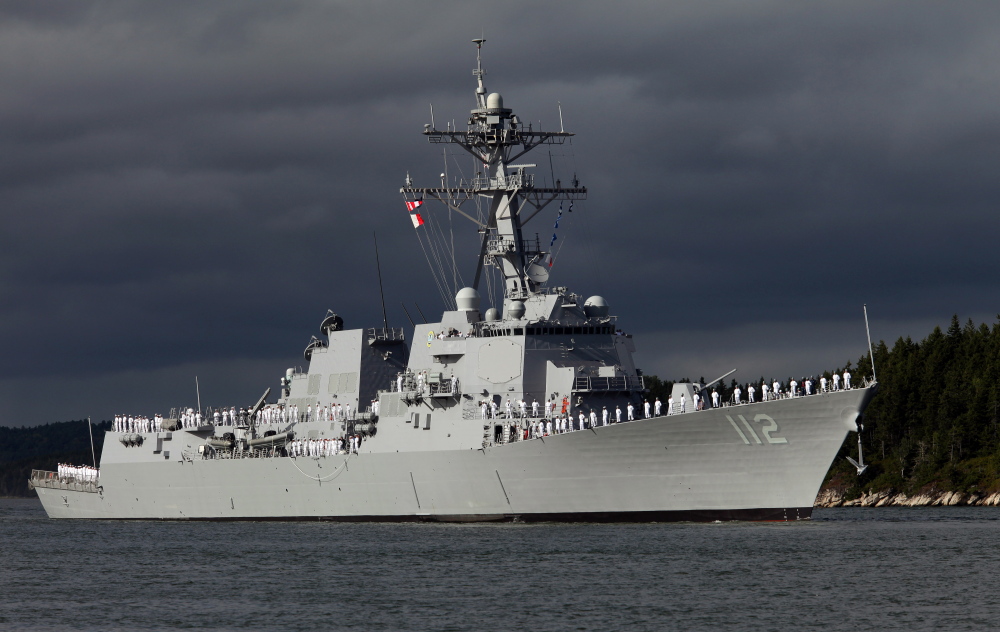The Navy is calling for a dramatic increase in the size of its combat fleet, a costly shift that could lead to additional work at Bath Iron Works and other Navy shipyards.
A Navy assessment of future needs to counter emerging threats recommends achieving a 355-ship fleet – compared with a current fleet of fewer than 280 ships – within the next 30 years. That proposes 47 more ships than the 308-ship goal set by the last “force structure assessment” released just two years ago and would require a significant increase in the pace of Navy shipbuilding.
The document recommends 16 additional “large surface combatants” over the 2014 report, bringing to 104 the number of guided-missile destroyers and cruisers that are the workhorses of the Navy and escort aircraft carriers. Only two shipyards in the U.S. – Maine’s Bath Iron Works and Ingalls Shipbuilding in Pascagoula, Mississippi – currently build destroyers for the Navy.
The Navy’s 355-ship goal also calls for the addition of 18 attack submarines and one additional aircraft carrier.
“To continue to protect America and defend our strategic interests around the world, all while continuing the counterterrorism fight and appropriately competing with a growing China and resurgent Russia, our Navy must continue to grow,” Secretary of the Navy Ray Mabus said in a statement. “All of the analysis done to date, inside and outside of the Navy, recognizes, as we have for nearly the last eight years, the need for a larger fleet.”
Maine Sens. Susan Collins and Angus King, who serve on committees that deal with defense and shipbuilding budgets, welcomed what they described as a “candid assessment of the naval fleet that is necessary to protect the United States.” The Navy’s call for additional ships comes several months after BIW lost a multibillion-dollar competition to build the next-generation Coast Guard cutter.
“Navy Secretary Ray Mabus has been a staunch supporter of shipbuilding during his eight-year tenure, and we applaud him today for taking a fresh look at the necessary size and capability of the Navy’s fleet, particularly while China continues to modernize its own naval forces,” Collins and King said in a joint statement. “The Navy’s new 355-ship goal is not only an important benchmark to achieve for our nation’s security, but good news for Bath Iron Works and the state of Maine, where the Navy’s world-class destroyers are built.”
The Navy’s current budget calls for funding construction of two Arleigh Burke-class destroyers per year, with the work traditionally split between BIW and Ingalls Shipbuilding. BIW, which is owned by General Dynamics, is also building the two final ships in the new class of Zumwalt “stealth” destroyers.
But BIW recently lost the Coast Guard cutter contract, potentially worth $10.5 billion, raising concerns the shipyard may have to shed 1,000 to 1,200 jobs as the pace of Navy work slows with the completion of the Zumwalt-class destroyers. So the prospect of a more aggressive Navy shipbuilding program would be welcome news at the yard.
Representatives from BIW and General Dynamics’ corporate headquarters in Virginia did not respond to requests for comment Friday on the Navy recommendation. Electric Boat, a General Dynamics shipyard in Groton, Connecticut, also would likely see a considerable increase in work if the Navy added the 18 attack submarines to the 30-year plan. The NASSCO shipyard in San Diego, which is also owned by General Dynamics, also would likely see a boost in demand for support ships built there.
Of course, the Navy’s 355-ship goal is just that – a goal based on current and perceived threats – and does not obligate Congress or future presidents to follow it. However, President-elect Donald Trump has also called for returning to a 350-ship Navy.
In pre-election speeches, Trump talked about the need for additional missile-defense capabilities offered by destroyers.
“As we expand our Navy toward the goal of 350 ships, we will also procure additional modern destroyers that are designed to handle the missile defense mission in the coming years,” Trump said, according to a transcript of a September speech. “Accomplishing this military rebuild will be a 50-state effort. Every state in the union will be able to take part in rebuilding our military and developing the technologies of tomorrow.”
Achieving a 350-ship or 355-ship Navy would not be easy or inexpensive.
In its 355-ship recommendation, the Navy assumed that Trump and the Republican-led Congress will act to eliminate the automatic budget cuts that Navy officials say have slowed the shipbuilding program. Congress has been unable or unwilling to eliminate the so-called “sequestration” cuts under President Obama.
A recent analysis by the nonpartisan Congressional Research Service estimated that a 350-ship Navy would require $3.5 billion to $4 billion in additional funding every year over the 30-year build-out period.
Send questions/comments to the editors.




